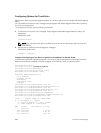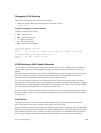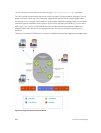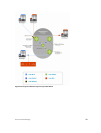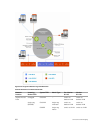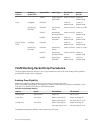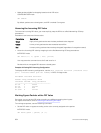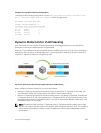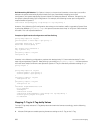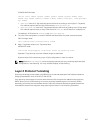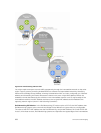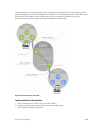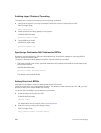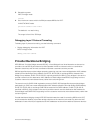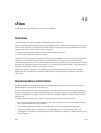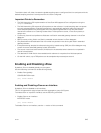
Dell Networking OS Behavior: For Option A shown in the previous illustration, when there is a conflict
between the queue selected by Dynamic Mode CoS (vlan-stack dot1p-mapping) and a QoS
configuration, the queue selected by Dynamic Mode CoS takes precedence. However, rate policing for
the queue is determined by QoS configuration. For example, the following access-port configuration
maps all traffic to Queue 0:
vlan-stack dot1p-mapping c-tag-dot1p 0-7 sp-tag-dot1p 1
However, if the following QoS configuration also exists on the interface, traffic is queued to Queue 0 but
is policed at 40Mbps (qos-policy-input for queue 3) because class-map "a" of Queue 3 also matches
the traffic. This is an expected behavior.
Examples of QoS Interface Configuration and Rate Policing
policy-map-input in layer2
service-queue 3 class-map a qos-policy 3
!
class-map match-any a layer2
match mac access-group a
!
mac access-list standard a
seq 5 permit any
!
qos-policy-input 3 layer2
rate-police 40
Likewise, in the following configuration, packets with dot1p priority 0–3 are marked as dot1p 7 in the
outer tag and queued to Queue 3. Rate policing is according to qos-policy-input 3. All other packets
will have outer dot1p 0 and hence are queued to Queue 1. They are therefore policed according to
qos-
policy-input 1.
policy-map-input in layer2
service-queue 1 qos-policy 1
service-queue 3 qos-policy 3
!
qos-policy-input 1 layer2
rate-police 10
!
qos-policy-input 3 layer2
rate-police 30
!
interface GigabitEthernet 0/21
no ip address
switchport
vlan-stack access
vlan-stack dot1p-mapping c-tag-dot1p 0-3 sp-tag-dot1p 7
service-policy input in layer2
no shutdown
Mapping C-Tag to S-Tag dot1p Values
To map C-Tag dot1p values to S-Tag dot1p values and mark the frames accordingly, use the following
commands.
1. Allocate CAM space to enable queuing frames according to the C-Tag or the S-Tag.
836
Service Provider Bridging



